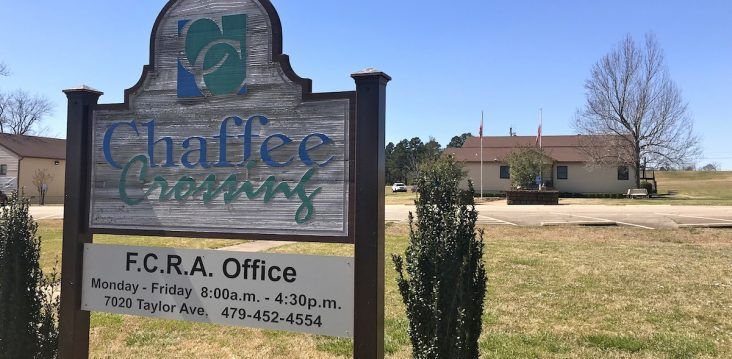Lawsuit filed against FCRA over land use change in historic district
by May 21, 2019 8:12 pm 1,312 views

Several Chaffee Crossing property owners filed a lawsuit in Sebastian County Circuit Court Friday (May 17) against the Fort Chaffee Redevelopment Authority and its board of directors because of a land use change the board approved in the Chaffee historic district.
On April 18, the FCRA board voted to change land use in part of the “historic warehouse district” to industrial/office. The vote came after weeks of sometimes heated discussion on how to rectify an issue of some properties used in non-conforming ways. The board voted to change the area bounded by Darby Avenue, Taylor Avenue, Roberts Boulevard and Terry Street from mixed use: historic use to industrial/office. This will change the area south of Darby Avenue in the historic area but leave the area north of Darby as mixed use: historic.
The lawsuit was filed by Randy and Tina DeCanter with Old Fort Furniture; John Coats with JKC Cellars LLC and KRIJO Investments; Tasha and Alan Taylor with Truckin Delicious; Quentin Willard with Fort Smith Brewing Co. and QB Ventures and Micah Spahn with Fort Smith Brewing Co.
The lawsuit states that the land use change should be deemed invalid because it was of a violation of due process; the land use change is not shown to be in the public interest but rather was “arbitrary and capricious” and was for the benefit of specific land owners rather than the public as a whole; and “taking with no public purpose is invalid.”
The revisions to the land use were needed to accommodate property development by CBC Construction & Development, Beam Properties and Blake Properties, all of which have industrial warehouses in the area. However, at the same meeting where FCRA approved the land use change, the board approved swapping property with CBC Construction & Development so their warehouse would no longer be located in the area in contention. Prior to the land use change, industrial warehouses were of nonconforming use in the specified area. This meant those business could not get approval from the Fort Smith planning and zoning department for any changes or improvements to their property.
During several meetings on the proposed change in land use, property owners who operate with a conforming use in the affected area raised objections to the change. They said changing the land use would harm the historic integrity of the area and not allow it to be a walking, shopping, dining, tourist-drawing and business area. The business owners contend this was the concept they were sold in the area’s master plan and changing the land use will cause property values to fall and keep other businesses from locating to the area.
The lawsuit contends that master development guidelines developed by FCRA for the plaintiff’s area is to consist of 55% office, 25% office, 25% institutional and 15% commercial and that the “classification of mixed use: historic area is designated to facilitate the creation of a pedestrian-friendly environment to encourage the redevelopment of the historic core into a community and/or tourist destination.”
During discussions of the how to deal with “nonconforming property” in the area, FCRA board members said Beam Properties and Blake Properties had been in their buildings for many years and the property was allowed prior to the master plan development. However, the lawsuit states the nonconforming properties were purchased between March 27, 2017, and April 17, 2018.
The lawsuit also states that changes can only be made to the master development guidelines “only where there is a mistake, unanticipated changes since enactment and only when same is for benefit of the public interest and serves a public purpose.” The lawsuit argues that the land use change was not to serve a public purpose but rather was “clearly an action to benefit individual landowners … in order to cure the issues made when FCRA permitted the contracts, and subsequent purchases, to be approved having nonconforming use.”
“The FCRA could not answer inquiries at the time of the final vote (on the land use change) regarding the impact on environment and surrounding businesses, the harm to market values for owners who relied on the Master Development Guidelines, and in fact, the FCRA Board of Trustees could not even provide parameters for what industrial-type of entities could now operate in the Historic Area which is designated a ‘walk and shop tourist destination,’” the lawsuit states.
At the time of the board made the land use change, FCRA attorney Dalton Person said any existing business inside the area with the land use change who were conforming to the old usage would still conform to the new use. No one named in the lawsuit had been served with the lawsuit by Tuesday afternoon, Person said. Dean Gibson, board chairman, said he was aware of the lawsuit but had not yet seen it.
After talking to the FCRA board, Person issued the following statement, “The FCRA and its volunteer board of trustees always strive to uphold its mission and act in the public’s interest. While it has not been served with the lawsuit, FCRA looks forward to the opportunity to present its case in court.”
